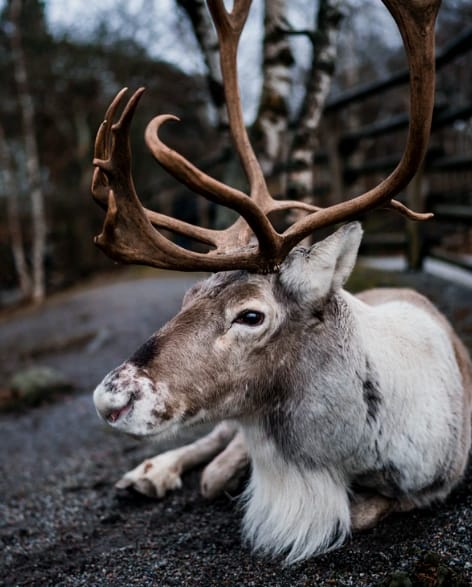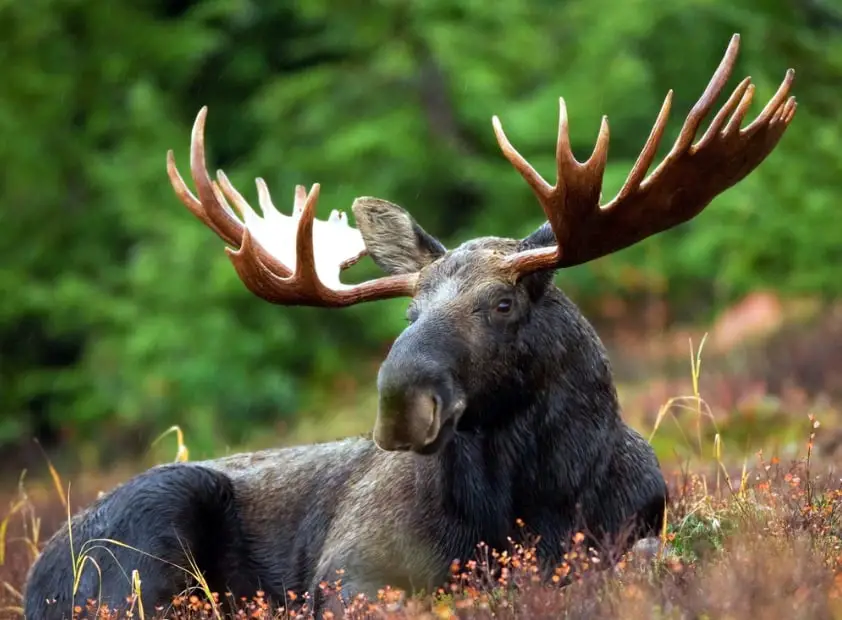As an Amazon Associate I earn from qualifying purchases.
Our Associate portal can be found here
Introduction
The Moose and Caribou are both members of the Cervidae family; however, they are two different species. A significant number of individuals tend to have difficulties in differentiating these two. Their features are not that far much apart, however for those keen on the eye, you will not fail to notice that the latter is greater in size than the former. I believe that this is the most significant between the two. There are other differences as you will learn from this piece, so what is the difference between Caribou and Moose?
To get a clear understanding of what differentiates the two, you first need to familiarize yourself with both of these members of the deer family.
Caribou

The Caribou are known to most as the Reindeer. If you believe in the Christmas spirit, well, this is the animal that is said to push Santa’s sleigh. These beasts inhabit arctic and sub-arctic regions, and their anatomy has developed with time and made them comfortable under shallow temperatures.
The Caribou has two main subspecies under it; Tundra and Woodland reindeer. The Reindeer is a large animal that is both a predator and prey. They have always been associated with humans, acting as a source of food and transport, their bodies are energetic enough to push sleighs on ice.
Moose

The Moose’s nomenclature term is Alces Americanus, found in the deer family. They are large animals with massive figures and outstanding antlers. Its origins are from North America and distribute evenly to Asia and Europe.
They are herbivorous animals and mostly move in herds. Most active in the daytime where they search for food and water.
The Moose prefers dense forest cover to help it camouflage through the growing vegetation. At the same time, the thick vegetation provides the Moose with adequate food and water well within its home range. It can live up to 20 years, depending on the hunter and predator relationship around its habitat.
Differences between the Caribou and the Moose
Physical Differences
Appearance
A significant number of caribous appear to have shaggy brown fur in most regions. However, in some areas, their hair is entirely white. On its neck lies a fold of loose skin covered with white hairs on its throat. Since they mostly inhibit low-temperature regions, double-layered fur increases its ability to retain body temperature.
The Reindeer is the only member of its family to have antlers in both females and males.
Moose can be distinguished from a caribou by its grey fur color and a hump on their shoulders. They are taller and have a spot in the tallest mammals that inhabit North America. A short tail graces their behinds.
Size
Anyone who has seen both of these animals will agree that the Moose is more prominent than Caribou. The moose shoulder height is 2 meters, with its weight varying on the sex of the animal. The male gender is practically heavier, weighing 400-700 kg; the female weighs at around 250- 350 kg. This female’s weight might increase significantly after the mating season when expecting a fawn.
On the other hand, the Moose weighs 90-210 kg with a shoulder height of 1.5m. The Moose cannot weigh past 300 kilograms, and it might lose its running speed and leg balance.
Antlers
Antlers are a protruding bone structure protruding from the crown of the species head; both of these animals have antlers. It is familiar to their family. The antlers are blunt in both animals and covered with a velvet coating.
The Caribou is the only species in this family that brags of having an antler in both sexes. The other species only have them on the males, including the Moose. The caribous also enjoy the fact that they have the most massive antlers in their family. The Moose’s antler connects and pieces itself together held with a continuous flattened board.
Physiological and Natural Differences
Diversity
There are practically more subspecies under the Caribou than the Moose. The Moose has six subspecies, whereas the Caribou has nine subspecies.
Under the Caribou there are two subspecies;
- The Tundra reindeer which has a total of six subspecies
- The Woodland reindeer that has three subspecies
Habitat
These animals inhabit regions that experience a vast difference in the climate. Caribou prefer arctic and subarctic areas, which are too cold for the Moose to survive in. One of the features that evolved on the Reindeer is its coating fur. Due to the freezing temperatures experienced in their inhabiting regions, their coating developed smooth hair that reduces body heat loss.
The Moose is likely to be too stressed in low temperatures since it has not adapted to the cold.
Diet
We all know that the Moose is strictly herbivorous. Unlike the herbivorous Moose, the Caribou is omnivorous. These animals are not limited to grass only; they can also eat flesh. The Moose, on the other hand, is only limited to green vegetation. This diet does not restrict nutrient input, and a moose can eat up to 30kg of grass each day. Both of their foods provide maximum nutrients to aid in the growth of their unique antlers.
Reproduction
The mating season for the Moose begins from September to October; this is earlier than the caribous, only in October. The latter has a short mating and gestation period, the Moose’s gestation is approximately eight months. Calving occurs from late May to June. The Moose avoids calving during the winter with fears of the calf, not making it through the cold season.
The Caribou’s gestation period, on the other hand, ranges from 225-235 days. There is not much difference in the periods, and birth occurs when there is enough food.
Migration
North American Caribou migrate furthest than any other mammal. It can travel up to 5000 km away, covering a vast distance. This is only for the North American breed, European and other region reindeers migrate shorter distances.
The migration of these animals has its downsides, one of them being that these animals are highly susceptible to parasite loads that cut the migration journey. Other limitations when moving is the exposure to predators and diseases that kill a significant number during the migration.
Moose rarely migrate; however, if they do, moving has to be higher than that of staying. Their reluctance to migrate is because they inhabit one of the largest home ranges in mammals. Minnesota based Moose were found to move distances between 8.7-21.2 miles while Alaska based travel 9.9-57.8 miles. Migrating Moose follows the same path with every migration.
Domestication
The Cervidae family are animals with a wild instinct. Their features and characteristics are best suited for the wild; however, certain species under this family are domesticated.
The Caribou is one of the domesticated species, and they act as a means of transport by pushing around sleighs on ice. Their meat, milk, and skin serve as a purpose to humans; this is most evident in the northern areas. The Reindeer’s hide has more insulating capabilities than other leathers due to their soft furs. Humans use this hide to make blankets and articles of clothing for warmth.
Moose, on the other hand, tend to dwell in the wild. They are great survivalists and know how to take care of themselves in the wild. Hunters tend to collect some of their shed antlers as trophies. Their hides and hooves do not serve many purposes.
Behavioral Differences
Aggression
Generally, Moose is not aggressive towards humans. However, if the animal feels provoked, they do attack. See more reasons here on Why is the Moose So Aggressive?
Moose related attacks are very rampant; the good thing is that they only inflict minor injuries to their victims.
Domesticated Moose might attack the human if denied adequate food; this comes with other negative behaviors like becoming too noisy. Be on the lookout for the calved species; they tend to be overprotective and might charge with the slightest intimidation.
Are Moose Dangerous? Like every wild animal, they are unpredictable, so be cautious when close to them.
The Caribou is also not that aggressive and only attacks when threatened. The male species is more aggressive than the female; this is similar to most of the animals in the Cervidae family. They are very intense and can cause immense damage to either predators or humans.
On the other hand, the females are very social and seem to enjoy the company of other animals. This gregarious nature is what contributes to the lasting relationship between Caribou and humans.
Hunting Accessories You Didn’t Know You Needed
Conclusion
It is effortless to distinguish between the two, the antler and color of their coat will tell you if it is a moose or Caribou. Moose have a more massive body structure and antler than a caribou. Both of their antlers serve the same purposes and shed after every mating season. These two animals are outstanding players in the wild.
Although they have similar characteristics and features, they also have numerous unique characteristics, as discussed above.
Amazon and the Amazon logo are trademarks of Amazon.com, Inc, or its affiliates.

36 years old, been hunting and fishing my entire life – love the outdoors, family, and all kinds of hunting and fishing! I have spent thousands of hours hunting hogs and training hunting dogs, but I’m always learning new stuff and really happy to be sharing them with you! hit me up with an email in the contact form if you have any questions.


